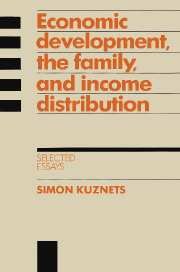Book contents
- Frontmatter
- Contents
- Preface by Louis Galambos and Robert Gallman
- Foreword by Richard A. Easterlin
- 1 Driving forces of economic growth: what can we learn from history?
- 2 A note on production structure and aggregate growth
- 3 The pattern of shift of labor force from agriculture, 1950–70
- 4 Modern economic growth and the less developed countries
- 5 Notes on demographic change
- 6 Recent population trends in less developed countries and implications for internal income inequality
- 7 Demographic aspects of the size distribution of income: an exploratory essay
- 8 Size and age structure of family households: exploratory comparisons
- 9 Size of households and income disparities
- 10 Distributions of households by size: differences and trends
- 11 Children and adults in the income distribution
- Afterword: Some notes on the scientific methods of Simon Kuznets by Robert William Fogel
- Bibliography of Simon Kuznets
- Index
11 - Children and adults in the income distribution
Published online by Cambridge University Press: 12 November 2009
- Frontmatter
- Contents
- Preface by Louis Galambos and Robert Gallman
- Foreword by Richard A. Easterlin
- 1 Driving forces of economic growth: what can we learn from history?
- 2 A note on production structure and aggregate growth
- 3 The pattern of shift of labor force from agriculture, 1950–70
- 4 Modern economic growth and the less developed countries
- 5 Notes on demographic change
- 6 Recent population trends in less developed countries and implications for internal income inequality
- 7 Demographic aspects of the size distribution of income: an exploratory essay
- 8 Size and age structure of family households: exploratory comparisons
- 9 Size of households and income disparities
- 10 Distributions of households by size: differences and trends
- 11 Children and adults in the income distribution
- Afterword: Some notes on the scientific methods of Simon Kuznets by Robert William Fogel
- Bibliography of Simon Kuznets
- Index
Summary
Introduction
If families or households are grouped by their size, as measured by number of persons, the common finding is that the larger families or households show a larger income per unit. But if the family or household income is divided by the number of members, per person income is larger in the smaller families or households and smaller in the larger units. An illustration of the positive association between the size of family and income per family, and of the negative association between size of family and family income per person, is provided in Table 11.1 below for the United States in 1969–70 (money income is for calendar 1969 and size of family is shown for March 1970). Income per family ranged from a low of $8.8 thousand for a family of two persons to $12.2 thousand for a family of five or six persons and $11.5 thousand for a family of seven persons or more. Family income per person declined sharply from $4.4 thousand for families of two persons to $1.4 thousand for families of seven or more.
Larger families or households usually contain a higher proportion of children among the members and a smaller proportion of adults than the smaller families or households. It follows that children are more concentrated than adults in larger families or households and, consequently, in families or households with lower per person income.
- Type
- Chapter
- Information
- Economic Development, the Family, and Income DistributionSelected Essays, pp. 370 - 412Publisher: Cambridge University PressPrint publication year: 1989



